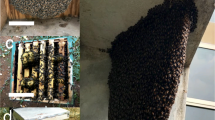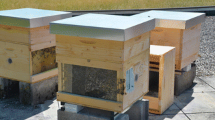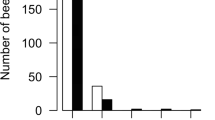Abstract
Insect societies are important models for evolutionary biology and sociobiology. The complexity of some eusocial insect societies appears to arise from self-organized task allocation and group cohesion. One of the best-supported models explaining self-organized task allocation in social insects is the response threshold model, which predicts specialization due to inter-individual variability in sensitivity to task-associated stimuli. The model explains foraging task specialization among honeybee workers, but the factors underlying the differences in individual sensitivity remain elusive. Here, we propose that in honeybees, sensory sensitivity correlates with individual differences in the number of sensory structures, as it does in solitary species. Examining European and Africanized honeybees, we introduce and test the hypothesis that body size and/or sensory allometry is associated with foraging task preferences and resource exploitation. We focus on common morphological measures and on the size and number of structures associated with olfactory sensitivity. We show that the number of olfactory sensilla is greater in pollen and water foragers, which are known to exhibit higher sensory sensitivity, compared to nectar foragers. These differences are independent of the distribution of size within a colony. Our data also suggest that body mass and number of olfactory sensilla correlate with the concentration of nectar gathered by workers, and with the size of pollen loads they carry. We conclude that sensory allometry, but not necessarily body size, is associated with resource exploitation in honeybees and that the differences in number of sensilla may underlie the observed differences in sensitivity between bees specialized on water, pollen and nectar collection.




Similar content being viewed by others
References
Alexander RD (1974) The evolution of social behavior. Annu Rev Ecol Syst 5:325–383
Apfelbach R, Russ D, Slotnick BM (1991) Ontogenetic changes in odor sensitivity, olfactory receptor area and olfactory receptor density in the rat. Chem Sens 16:209–218
Benjamini Y, Hochberg Y (1995) Controlling the false discovery rate: a practical and powerful approach to multiple testing. J Roy Stat Soc B 57:289–300
Beshers SN, Fewell JH (2001) Models of division of labor in social insects. Annu Rev Entomol 46:413–440
Beshers SN, Robinson GE, Mittenthal JE (1999) Response thresholds and division of labor in insect colonies. In: Detrain C, Deneubourg JL, Pasteels JM (eds) Information processing in social insects. Birkhauser, Basel, pp 115–139
Bonabeau E, Theraulaz G, Deneubourg JL, Aron S, Camazine S (1997) Self-organization in social insects. Trends Ecol Evol 12:188–193
Bonabeau E, Theraulaz G, Deneubourg JL (1999) Dominance order in animal societies: the self-organization hypothesis revisited. B Math Biol 61:727–757
Bosch J, Vicens N (2006) Relationship between body size, provisioning rate, longevity and reproductive success in females of the solitary bee Osmia cornuta. Behav Ecol Sociobiol 60:26–33
Calderone NW, Page RE (1988) Genotypic variability in age polyethism and task specialization in the honeybee, Apis mellifera (Hymenoptera: Apidae). Behav Ecol Sociobiol 30:219–226
Chapman RF (1998) The Insects: structure and function, 4th edn. Cambridge University Press
Cideciyan M (1984) The relationship between size and behavior in worker honey bees (Apis mellifera). Thesis. University of Miami
Domínguez M, Casares F (2005) Organ specification-growth control connection: new in-sights from the Drosophila eye-antennal disc. Dev Dynam 232:673–684
Erber J, Hoorman J, Scheiner R (2006) Phototactic behaviour correlates with gustatory responsiveness in honeybees (Apis mellifera L.). Behav Brain Res 174:174–180
Farooqui T (2007) Octopamine-mediated neuromodulation of insect senses. Neurochem Res 32:1511–1529
Fjerdingstad EJ, Crozier RH (2006) The evolution of worker caste diversity in social insects. Amer Nat 167:390–400
Frederiksen R, Warrant EJ (2008) Visual sensitivity in the crepuscular owl butterfly Caligo memnon and the diurnal blue morpho Morpho peleides: a clue to explain the evolution of nocturnal apposition eyes? J Exp Biol 211:844–851
Harrison JM (1986) Caste-specific changes in honeybee flight capacity. Physiol Zool 59:175–187
Hayes EJ, Wall R (1999) Age-grading adult insects: a review of techniques. Physiol Entomol 24:1–10
Hellmich RL, Kulincevic JM, Rothenbuhler WC (1985) Selection for high and low pollen hoarding honey bees (Apis mellifera). J Hered 76:155–158
Higashi M, Yamamura N, Abe T (2000) Theories on the sociality of termites. In: Abe T, Bignell DE, Higashi M (eds) Termites: Evolution, Sociality, Symbioses, Ecology. Kluwer Academic Publishers, pp 169–187
Higginson AD, Barnard CJ (2004) Accumulating wing damage affects foraging decisions in honeybees (Apis mellifera L.). Ecol Entomol 29:52–59
Hölldobler B, Wilson EO (1990) The ants. Harvard University Press, Cambridge
Hölldobler B, Wilson EO (2008) The superorganism: the beauty, elegance, and strangeness of insect societies. W.W. Norton & Co, New York
Humphries MA, Fondrk MK, Page RE (2005) Locomotion and the pollen hoarding behavioral syndrome of the honey bee (Apis mellifera L.). J Comp Physiol A 191:669–674
Jander U, Jander R (2002) Allometry and resolution of bee eyes (Apoidea). Arthropod Struct Dev 30:179–193
Jeanson R, Fewell JH, Gorelick R, Bertram SM (2007) Emergence of increased division of labor as a function of group size. Behav Ecol Sociobiol 62:289–298
Johnson BR (2002) Reallocation of labor in honeybee colonies during heat stress: the relative roles of task switching and the activation of reserve labor. Behav Ecol Sociobiol 51:188–196
Kapustjanskij A, Streinzer M, Paulus HF, Spaethe J (2007) Bigger is better: implications for flight ability under different conditions and evolution of alloethism in bumblebees. Funct Ecol 21:1130–1136
Kelber A, Warrant EJ, Pfaff M, Wallen R, Theobald JC, Wcislo WT (2006) Light intensity limits foraging activity in nocturnal and crepuscular bees. Behav Ecol 17:63–72
Kerr WE, Hebling NJ (1964) Influence of the weight of worker bees on division of labor. Evolution 18:267–270
Lindauer M (1952) Ein Beitrag zur Frage der Arbeitsteilung im Bienenstaat. Zeitschrift fur Vergleichende Physiologie 34:299–345
Linksvayer TA, Fondrk MK, Page RE Jr (2009) Honeybee social regulatory networks are shaped by colony level selection. Am Nat 173:E99–E107
Mertl AL, Traniello JFA (2009) Behavioral evolution in the major worker subcaste of twig-nesting Pheidole (Hymenoptera: Formicidae): does morphological specialization influence task plasticity? Behav Ecol Sociobiol. doi:10.1007/s00265-009-0797-3
Michener CD (1974) The social behavior of the bees. Harvard University Press, Cambridge
Milne CP (1985) An estimate of heritability of corbicular area of the honeybee. J Apicul Res 24:137–139
Milne CP, Friars GF (1984) An estimate of the heritability of honeybee pupal weight. J Hered 75:509–510
Milne CP, Hellmich RL, Pries KJ (1986) Corbicular size in workers from honeybee lines selected for high or low pollen hoarding. J Apicult Res 25:50–52
Moritz R, Page RE (1999) Behavioral threshold variability, cost and benefits in insect societies. In: Detrain C, Deneubourg JL, Pasteels JM (eds) Information processing in social insects. Birkhauser, Basel, pp 203–218
Nijhout HF (2003) The control of growth. Development 130:5863–5867
Oldroyd BP, Fewell JH (2007) Genetic diversity promotes homeostasis in insect colonies. Trends Ecol Evol 22:408–413
Oster GF, Wilson EO (1978) Caste and ecology in the social insects. Princeton University Press, Princeton
Page RE, Fondrk MK (1995) The effects of colony-level selection on the social organization of honey bee (Apis mellifera L.) colonies: colony-level components of pollen hoarding. Behav Ecol Sociobiol 36:135–144
Page RE, Mitchell SD (1998) Self-organization and the evolution of division of labor. Apidologie 29:171–190
Page RE, Amdam GV (2007) The making of a social insect: developmental architectures of social design. Bioessays 29:334–343
Page RE Jr, Erber J, Fondrk MK (1998) The effect of genotype on response thresholds to sucrose and foraging behavior of honeybees (Apis mellifera). J Comp Physiol A 182:489–500
Page RE Jr, Scheiner R, Erber J, Amdam GV (2006) The development and evolution of division of labor and foraging specialization in a social insect. Curr Top Dev Biol 74:253–286
Page RE, Linksvayer TA, Amdam GV (2009) Social life from solitary regulatory networks: a paradigm for insect sociality. In: Gadau J, Fewell F (eds) Organization of insect societies: from genomes to socio-complexity. Harvard University Press, Cambridge, pp 357–376
Pankiw T, Page RE Jr (1999) The effect of genotype, age, sex, and caste on response thresholds to sucrose and foraging behavior of honeybees (Apis mellifera). J Comp Physiol A 185:207–213
Pankiw T, Page RE Jr (2000) Response thresholds to sucrose predict foraging behavior in the honey bee (Apis mellifera L.). Behav Ecol Sociobiol 47:265–267
Pankiw T, Page RE Jr (2001) Genotype and colony environment affect honeybee (Apis mellifera L.) developmental and foraging behavior. Behav Ecol Sociobiol 51:87–94
Pankiw T, Tarpy DR, Page RE Jr (2002) Genotype and rearing environment affect honeybee perception and foraging behaviour. Anim Behav 64:663–672
Poklukar J, Kezic N (1994) Estimation of heritability of some characteristics of hind legs and wings of honeybee workers (Apis mellifera carnica) using the half-sibs method. Apidologie 25:3–11
Scheiner R, Erber J (2009) Sensory thresholds, learning and the division of foraging labor in the honey bee. In: Gadau J, Fewell J (eds) Organization of insect societies: from genomes to socio-complexity. Harvard University Press, Cambridge, pp 335–356
Scheiner R, Page RE, Erber J (2004) Sucrose responsiveness and behavioral plasticity in honey bees (Apis mellifera). Apidologie 35:133–142
Scheiner R, Baumann A, Blenau W (2006) Aminergic control and modulation of honeybee behaviour. Curr Neuropharmacol 4:259–276
Schippers MP, Dukas R, Smith RW, Wang J, Smolen K, McClelland GB (2006) Lifetime performance in foraging honeybees: behaviour and physiology. J Exp Biol 209:3828–3836
Schneider D, Steinbrecht RA (1968) Checklist of insect olfactory sensilla. Sym Zool S 23:279–297
Schulz DJ, Pankiw T, Fondrk MK, Robinson GE, Page RE Jr (2004) Comparison of juvenile hormone hemolymph and octopamine brain titers in honey bees (Hymenoptera: Apidae) selected strains for high and low pollen hoarding. Ann Entomol Soc Am 97:1313–1319
Smith AR, Wcislo WT, O’Donnell S (2008) Body size shapes caste expression, and cleptoparasitism reduces body size in the facultatively eusocial bees Megalopta (Hymenoptera: Halictidae). J Insect Behav 21:394–406
Spaethe J, Weidenmüller A (2002) Size variation and foraging rate in bumblebees (Bombus terrestris). Insect Soc 142–146
Spaethe J, Chittka L (2003) Interindividual variation of eye optics and single object resolution in bumblebees. J Exp Biol 206:3447–3453
Spaethe J, Brockmann A, Halbig C, Tautz J (2007) Size determines antennal sensitivity and behavioral threshold to odors in bumblebee workers. Naturwissenschaften 94:733–739
Vareschi E (1971) Duftunterscheidung bei der Honigbiene—Einzelzellableitungen und Verhaltensreaktionen. Zeitschrift fur Vergleichende Physiologie 75:143–173
Verhoeven KJF, Simonsen KL, McIntyre M (2005) Implementing false discovery rate control: increasing your power. Oikos 108:643–647
Waddington KD (1981) Patterns of size variation in bees and evolution of communication systems. Evolution 35:813–814
Waddington KD (1988) Body size, individual behavior and social behavior in honey bees. In: Jeanne RL (ed) Interindividual behavioral variability in social insects. Westview Press, Boulder, pp 385–417
Waddington KD (2005) Implications of variation in worker body size for the honey bee recruitment system. J Insect Behav 2:91–103
Waddington KD, Herbst LH, Roubik DW (1986) Relationship between recruitment systems of stingless bees and within-nest worker size. J Kansas Entomol Soc 59:95–102
Wcislo WT (1995) Sensilla numbers and antennal morphology of parasitic and non-parasitic bees (Hymenoptera: Apoidea). Int J Insect Morphol 24:63–81
Wcislo WT, Tierney SM (2009) Behavioural environments and niche construction: the evolution of dim-light foraging in bees. Biol Rev 84:19–37
Wheeler DE, Buck N, Evans JD (2006) Expression of insulin pathway genes during the period of caste determination in the honey bee, Apis mellifera. Insect Mol Biol 15:597–602
Wilson EO (1975) [2000] Sociobiology: the new synthesis. 25th anniversary edition. Belknap, Cambridge
Wilson EO (1985) The principles of caste evolution. In: Hölldobler B, Lindauer M (eds) Experimental behavioral ecology and sociobiology. Sinauer, New York, pp 307–324
Acknowledgments
We thank Jorge Palacios for helping to collect bees, Ashley Wiede, Jonathan Kim, Chirag Patel, and Elizabeth Collier for preparing samples, taking pictures, and measuring bees. We thank Fabiola Santos for help measuring pollen loads. We thank Angelique Paulk for helpful suggestions on methods and Ruben Alarcon for help with the statistical analysis. We thank Gloria Degrandi-Hoffman and the USDA Carl Hayden Honey Bee Research Center for generously providing us with European honeybees. We thank Ruben Alarcon, Daniel Papaj, Diana Wheeler and two anonymous reviewers for constructive criticisms that contributed to improve this manuscript. This work was supported by a grant of the National Science Foundation of the United States of America (IOB-0519483) to WG. Additional support was provided by the Center for Insect Science (University of Arizona) to AJR.
Author information
Authors and Affiliations
Corresponding author
Additional information
Communicated by R. Moritz
Rights and permissions
About this article
Cite this article
Riveros, A.J., Gronenberg, W. Sensory allometry, foraging task specialization and resource exploitation in honeybees. Behav Ecol Sociobiol 64, 955–966 (2010). https://doi.org/10.1007/s00265-010-0911-6
Received:
Accepted:
Published:
Issue Date:
DOI: https://doi.org/10.1007/s00265-010-0911-6




